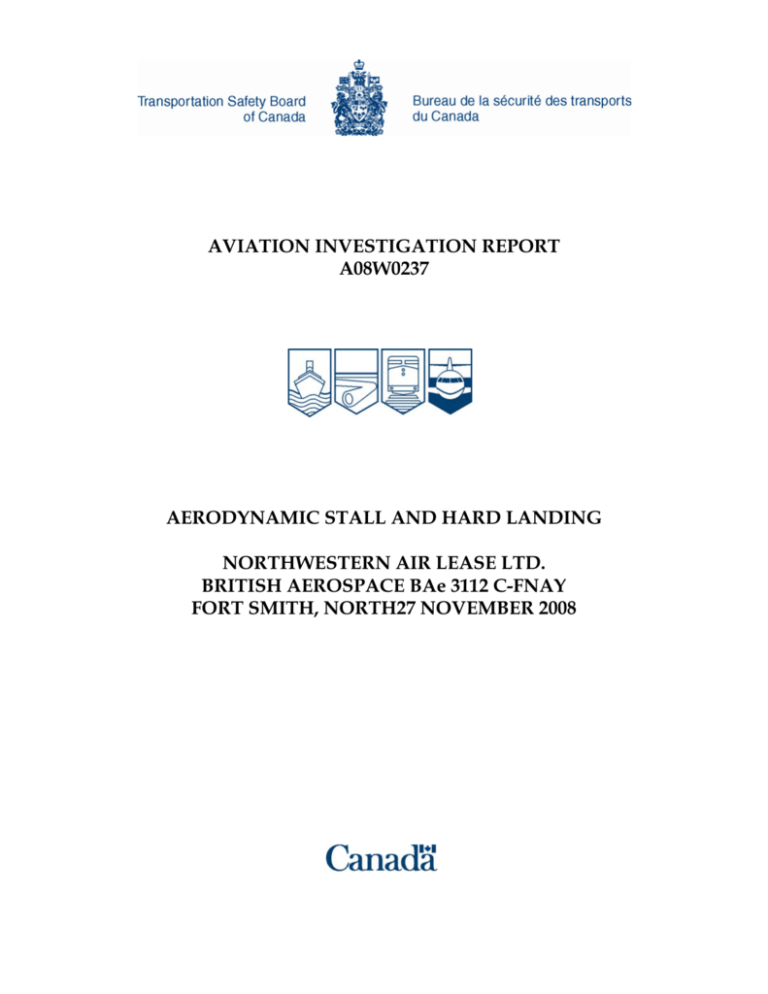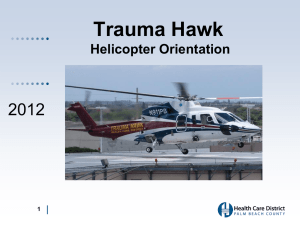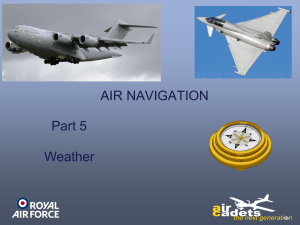Aerodynamic Stall and Hard Landing, Northwestern Air Lease Ltd
advertisement

AVIATION INVESTIGATION REPORT A08W0237 AERODYNAMIC STALL AND HARD LANDING NORTHWESTERN AIR LEASE LTD. BRITISH AEROSPACE BAe 3112 C-FNAY FORT SMITH, NORTH27 NOVEMBER 2008 The Transportation Safety Board of Canada (TSB) investigated this occurrence for the purpose of advancing transportation safety. It is not the function of the Board to assign fault or determine civil or criminal liability. Aviation Investigation Report Aerodynamic Stall and Hard Landing Northwestern Air Lease Ltd. British Aerospace BAe 3112 C-FNAY Fort Smith, Northwest Territories 27 November 2008 Report Number A08W0237 Summary The Northwestern Air Lease Ltd. BAe Jetstream 3112 (registration C-FNAY, serial number 768) was operating as PLR 734 on an instrument flight rules (IFR) flight from Hay River to Fort Smith, Northwest Territories. After conducting an IFR approach to Runway 11, PLR 734 executed a missed approach and flew a full procedure approach for Runway 29. At approximately 0.2 nautical miles from the threshold, the crew sighted the approach strobe lights and continued for a landing. Prior to touchdown, the aircraft entered an aerodynamic stall and landed hard on the runway at 1515 mountain standard time. The aircraft remained on the runway despite the left main landing gear collapsing. The two flight crew members and three passengers were uninjured and evacuated the aircraft through the left main cabin door. There was no post-impact fire. Ce rapport est également disponible en français. -2- Other Factual Information Northwestern Air Lease Ltd. holds valid air operations certificates issued under Subparts 703 – Air Taxi Operations, and 704 – Commuter Operations, of the Canadian Aviation Regulations (CARs) and is based in Fort Smith, Northwest Territories. In this occurrence, the aircraft was being operated under Subpart 704. The occurrence aircraft was certified, equipped, and maintained in accordance with existing regulations. There was no evidence to indicate that an airframe failure or systems malfunction contributed to this occurrence. The aircraft was equipped with a cockpit voice recorder (CVR). The CVR was removed from the aircraft and forwarded to the TSB Engineering Laboratory for analysis. The data recorded on the CVR covered the 30-minute period prior to the occurrence. The flight crew were licensed and qualified for the flight in accordance with the existing regulations. The pilot-in-command (PIC) had approximately 5500 hours of flight time, with 3000 hours on type and 1800 hours as PIC. The co-pilot had approximately 500 hours of flight time, with about 230 hours on type. On the occurrence flight, the captain was the pilot flying (PF) from the left seat and the co-pilot was the pilot not flying (PNF). The crew’s duty day was within the prescribed regulations. Fatigue was not a factor. PLR 734 began its operational day on 27 November 2008 at Fort Smith. The aircraft was to depart Fort Smith for a scheduled flight to Yellowknife and return. The crew arrived at the airport at approximately 0630 mountain standard time 1 to prepare for the flight and departed at 0730. At Yellowknife, prior to returning to Fort Smith, the crew checked the weather and determined that visibilities at Fort Smith at the time of arrival would be reduced to approximately ½ statute mile (sm). After consulting with company flight operations, it was decided that the crew would return to Fort Smith as scheduled, using Hay River as an alternate airport. Upon arrival at Fort Smith, the crew conducted two approaches: a VOR RWY 11 (GNSS) and a VOR/DME RWY 29 (GNSS). As visual reference to the runway could not be achieved, the crew diverted to Hay River, arriving at 1040, where they remained for approximately five hours waiting for the weather to improve. The weather conditions forecast at Fort Smith from 1100 to 2300 were as follows: winds were calm; visibility was ½ sm in freezing fog; vertical visibility was 500 feet. During that period, Fort Smith would experience a temporary condition of 6 sm visibility with no significant weather and an overcast ceiling of 600 feet above ground level (agl). 1 All times mountain standard time (Coordinated Universal Time minus seven hours). -3The 1400 weather at Fort Smith was reported as follows: winds 100° magnetic (M) at 2 knots; visibility 1 sm in mist; vertical visibility 400 feet; temperature -7°C; dew point -8°C; altimeter setting 29.97 inches of mercury (in. Hg); remarks: 8 oktas 2 fog, visibility to the southwest and southeast ½ sm. By 1500, the weather was observed to be: wind 170°M at 2 knots; visibility ½ sm in freezing fog; vertical visibility 500 feet; temperature -7°C; dew point -8°C; altimeter setting 29.98 in. Hg.; remarks 8 oktas fog, visibility to the north 5/8 sm. As visibility was reported to have improved to 1 sm, the crew departed Hay River for Fort Smith at 1427. While en route, the crew was advised that the visibility at Fort Smith had deteriorated to ½ sm. The crew continued on to Fort Smith and conducted the VOR RWY 11 (GNSS) approach. Visual reference to the runway was not achieved and the crew elected to conduct a missed approach followed by the full procedure approach for VOR/DME RWY 29 (GNSS) which had an advisory visibility of 1 sm (see Appendix A - VOR/DME RWY 29 (GNSS) Fort Smith, N.W.T.). Advisory Landing Visibilities 3 Published landing visibilities associated with all instrument approach procedures are advisory only. Their values are indicative of visibilities that, if prevailing at the time of the approach, should result in required visual reference being established. They are not limiting and are intended to be used by pilots only to judge the probability of a successful landing when compared against available visibility reports at the aerodrome to which an instrument approach is being carried out. Once established on final approach for Runway 29, the aircraft was configured with the landing gear extended and 20° of flap. The airspeed was 130 knots. PLR 734 descended to the minimum descent altitude (MDA) of 1000 feet above sea level (asl), 329 feet above ground level (agl), and planned to continue to the missed approach point (MAP) of 0.7 DME (distance measuring equipment), located at the threshold of Runway 29. 2 Cloud cover reported in eighths of the sky obscured 3 Aeronautical Information Manual (TP 14371E), Transport Canada, 2008-2, page 263 -4At approximately 0.9 DME, the approach strobe lights were sighted and the decision was made to land. Power was reduced to flight idle and 35° of flap were selected. Almost simultaneously, the crew slowed the aircraft down to the normal Vref 5 speed of 105 knots when the stall warning horn activated. Shortly thereafter, PLR 734 entered an aerodynamic stall and impacted the Required Visual Reference 4 runway. Power was applied prior to impact in an In respect of an aircraft on an attempt to recover from the stall. However, the aircraft came into contact with the runway before the approach to a runway, that section of the approach area of the runway or descent could be arrested. The company standard those visual aids that, when viewed by operating procedures (SOP) manual states that an the pilot of the aircraft, enable the pilot altitude loss of between 200 and 600 feet may be to make an assessment of the aircraft experienced during a stall, depending on the aircraft position and the rate of change of configuration, power setting, and rapidity of action position, relative to the normal flight taken to recover from the stall. The calculated stall path. speed in landing configuration for the occurrence aircraft was 83 knots (no ice contamination). The landing distance required with 35°flap was 3700 feet. The runway length at Fort Smith was 6000 feet. Northwestern Air Lease’s Jetstream SOP for non-precision straight-in approaches (2 engines) are as follows: The initial portion of the instrument approach is flown at 140 kts with Flaps 10, until established on the inbound track. When established on the inbound track, outside the FAF [final approach fix], the normal descent rate is 1500 FPM [feet per minute]. This, of course, may be modified, depending on the altitude to lose and distance available. When level at the beacon crossing altitude, approximately 2 miles from the FAF, the landing check is initiated with the PF calling, “GEAR DOWN, LANDING CHECKS, FLAPS 20” and the aircraft stabilized at 130 KIAS [knots indicated airspeed] prior to crossing the FAF. Upon crossing the FAF, the aircraft is descended to the MDA at 1000 FPM, under normal conditions. Flaps 35 are selected when the airport is visual. 6 4 Canada Air Pilot Instrument Procedures, General Pages, Definitions, page 10 5 Landing reference speed 6 Northwestern Air Lease Ltd. British Aerospace Jetstream 31 Standard Operating Procedures, Ed 1. Amend. 2, 12 May 2006, page 55 -5British Aerospace issued a Notice to Aircrew for the Jetstream 31, dated 20 November 2008, that made the following recommendation: 35° flap for landing should be selected at the marker or at 1000 feet, whichever comes first when on an instrument approach, and at 500 feet, when on a visual approach. Speed should then be controlled at 130 knots. Care should be taken to ensure that the speed does not fall below 125 knots until the aircraft is below 200 feet, then the speed may be reduced to achieve the required threshold speed. 7 The company had not incorporated information from this notice into its SOP manual at the time of the occurrence. PLR 734 touched down approximately 1053 feet past the threshold of Runway 29, on the left side of the centreline. There was an indication that the right wing tip struck the runway about 100 feet from the initial impact point. The left main landing gear collapsed and the aircraft skidded for 1778 feet before coming to rest on the runway. The crew and passengers were able to evacuate the aircraft through the left main cabin door, despite the door not fully opening due to the rear fuselage resting on the runway. Airport and company personnel arrived on site and assisted the crew and passengers to the airport terminal. There was no post-impact fire, despite fuel leaking from the left wing tip vent. Light to moderate icing conditions were encountered during the two approaches. While the amount of ice was not determined, photos taken of the aircraft by airport operations personnel on the day of the occurrence (1704) indicate that there was an accumulation of rime and clear ice along the wings and propeller spinners. The crew did not activate the aircraft’s de-icing equipment during the approaches. Icing is known to disrupt the smooth airflow over the wings, which produces the lift required to support the aircraft in flight. The result is an increase in the aircraft’s stalling speed. Additionally, ice formation increases the amount of wing drag which causes the airspeed to decrease at a rate faster than anticipated when power is reduced. The company SOP manual advised that, when encountering icing conditions, the Vref speed should be increased by up to 10 knots and that the airframe de-icing boots must be cycled. The crew did not activate the airframe de-icing boots or increase the Vref speed during the two approaches at Fort Smith. Analysis Aircraft icing is known to degrade aircraft performance. This was recognized in the company’s SOP, which advised an increase in Vref speed and the cycling of airframe de-icing boots when encountering icing conditions. The crew did not take either of these preventive actions during the course of the two approaches at Fort Smith. This was likely due to a preoccupation with 7 Jetstream 3100 Crew Manual, Vol. 2, Notice to Aircrew J31 005-1, 20 November 2008 -6flying the instrument approach in challenging conditions. Light to moderate icing conditions were encountered during the two approaches and this increased the stalling speed of the aircraft. The crew of PLR 734 flew the instrument approach for Runway 29 in accordance with established regulatory requirements and company SOP, absent icing conditions. The landing was initiated once the visual reference was established, at 0.9 DME (0.2 nm from the threshold) and 329 feet agl. This was well inside the advisory visibility of 1 sm. As a consequence, the crew had very little time or distance to configure the aircraft for landing. When the crew reduced the power to flight idle and applied 35° of flap to slow down to the normal Vref speed of 105 knots, the aircraft entered an aerodynamic stall due to the decreased performance caused by the icing. There was insufficient altitude to recover the aircraft prior to impact with the runway. Findings as to Causes and Contributing Factors 1. Though icing conditions were encountered, the airframe de-icing boots were not cycled nor was the Vref speed increased to offset the effects of aircraft icing. 2. An abrupt change in aircraft configuration, which included a reduction in power to flight idle and the addition of 35° flap, caused the aircraft’s speed to rapidly decrease. 3. The aircraft entered an aerodynamic stall due to the decreased performance caused by the icing. There was insufficient altitude to recover the aircraft prior to impact with the runway. Finding as to Risk 1. The company had not incorporated the British Aerospace Notice to Aircrew into its standard operating procedures (SOP) at the time of the occurrence. Therefore, crews were still required to make configuration changes late in the approach sequence, increasing the risk of an unstabilised approach. This report concludes the Transportation Safety Board’s investigation into this occurrence. Consequently, the Board authorized the release of this report on 29 April 2009. Visit the Transportation Safety Board’s Web site (www.tsb.gc.ca) for information about the Transportation Safety Board and its products and services. There you will also find links to other safety organizations and related sites. -7- Appendix A: Canada Air Pilot VOR/DME Runway 29 (GNSS) Fort Smith, Northwest Territories NOT TO BE USED FOR NAVIGATION






